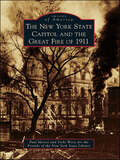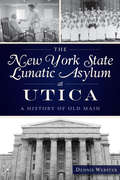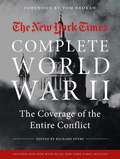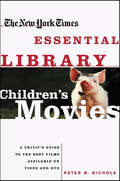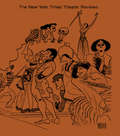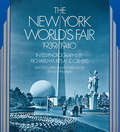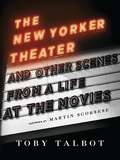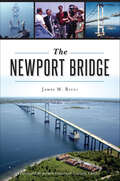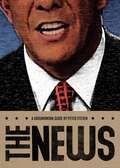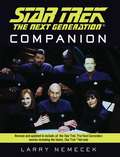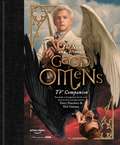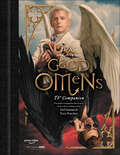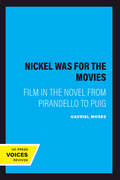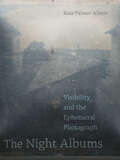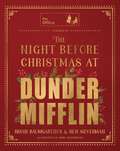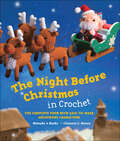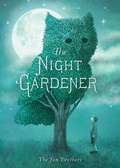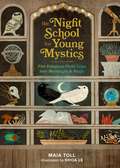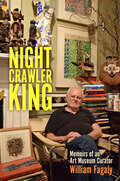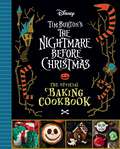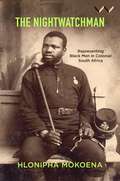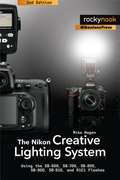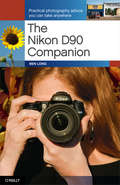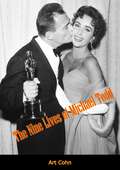- Table View
- List View
The New York State Capitol and the Great Fire of 1911 (Images of America)
by Vicki Weiss Paul MercerIn the early morning hours of March 29, 1911, a fire broke out in the New York State Capitol at Albany. By sunset, the entire western portion of the building had sustained extensive structural damage. Within lay the entire collection of the New York State Library, almost completely reduced to ashes. Founded in 1818, this had been one of the finest research libraries in the country and home to innumerable manuscript and printed rarities. In a particularly bitter irony, the fire struck as the overcrowded library was four months away from moving into new, spacious quarters under construction across the street. Miraculously there was only one fatality, an elderly watchman, Samuel Abbott, whose body was not recovered until several days later. Images of America: The New York State Capitol and the Great Fire of 1911 includes recently discovered photographs documenting the construction of the building, beginning in 1867, as well as eyewitness accounts of its destruction.
The New York State Lunatic Asylum at Utica: A History of Old Main
by Dennis WebsterKnown as "Old Main," the New York State Lunatic Asylum at Utica opened in 1843 as the first institution of its kind to treat madness as a medical illness, not a curse. A series of groundbreaking administrators sought to save mentally ill New Yorkers from lives of confinement in sordid conditions and create a safe haven. A sense of normalcy was established for patients through Old Main's Asylum Band, the Opal monthly publication and other arts programs. The infamous Utica Crib was invented at the asylum, and visitors from around the world sought to tour the facility and its utopian structure. Though closed in 1978, Old Main was placed in the National Register of Historic Places, and its iconic columns still mesmerize the public today. Author Dennis Webster charts the history of the New York State Lunatic Asylum at Utica.
The New York Times Complete World War II: The Coverage of the Entire Conflict
by Tom Brokaw Richard Overy The New York TimesExperience the history, politics, and tragedy of World War II through the original, often firsthand daily reportage of The New York Times, our country's newspaper of record.The Times' complete coverage of World War II is now available in a paperback edition of this unique book. Hundreds of the most riveting articles from the archives of the Times including firsthand accounts of major events and little-known anecdotes have been selected for inclusion in The New York Times: World War II. The book covers the biggest battles of the war, from the Battle of the Bulge to the Battle of Iwo Jima, as well as moving stories from the home front and profiles of noted leaders and heroes such as Winston Churchill and George Patton.A respected World War II historian and writer, editor Richard Overy guides readers through the articles, putting the events into historical context. Beautifully designed and illustrated with hundreds of maps and historical photographs, it's the perfect gift for any war, politics, or history buff.
The New York Times Essential Library: Children's Movies (The New York Times Essential Library)
by Peter M. NicholsAn indispensable guide for parents from a leading expert on children's filmFor years Peter M. Nichols has been offering vital advice and information for parents about current movies in his regular "Taking the Children" column. But parents need the same kind of guidance when renting or buying videos and DVDs for their family. They may know that movies such as Toy Story and Chicken Run are good choices for their children, but Nichols helps parents go beyond the obvious choices to more unconventional movies like The African Queen and Some Like It Hot. From the classics of animation to a host of great comedies and dramas, Nichols provides a knowing and illuminating guide to one hundred great cinematic works.Each brief original essay not only explains why the children will enjoy the film but also allows Nichols to offer timely bits of film history and to discuss certain films in a larger cultural context. Nichols's knowledge and understanding of films is broad and deep, and many of his choices-especially of films that we might not have thought of as "children's films"-will surprise and delight readers.
The New York Times Theater Reviews 1997-1998
by C. S. SmithFirst published in 2001. Routledge is an imprint of Taylor & Francis, an informa company.
The New York World's Fair, 1939/1940: in 155 Photographs by Richard Wurts and Others (New York City)
by Stanley Appelbaum Richard WurtsPhotographic tour of best-loved world's fair: the 700-foot-tall Trylon; the 200-foot-wide Perisphere; GM's Futurama ride; 3-D movies; Elektro the 7-foot-tall robot; artwork by Salvador Dali, Rockwell Kent, Alexander Calder, and much more. 155 photographs. Map. Introduction. Captions. Index.
The New Yorker Theater and Other Scenes from a Life at the Movies
by Toby TalbotThe nation didn't know it, but 1960 would change American film forever, and the revolution would occur nowhere near a Hollywood set. With the opening of the New Yorker Theater, a cinema located at the heart of Manhattan's Upper West Side, cutting-edge films from around the world were screened for an eager audience, including the city's most influential producers, directors, critics, and writers. Woody Allen, Martin Scorsese, Susan Sontag, Andrew Sarris, and Pauline Kael, among many others, would make the New Yorker their home, trusting in the owners' impeccable taste and incorporating much of what they viewed into their work. In this irresistible memoir, Toby Talbot, co-owner and proud "matron" of the New Yorker Theater, reveals the story behind Manhattan's wild and wonderful affair with art-house film. With her husband Dan, Talbot showcased a range of eclectic films, introducing French New Wave and New German cinema, along with other groundbreaking genres and styles. As Vietnam protests and the struggle for civil rights raged outside, the Talbots also took the lead in distributing political films, such as Bernard Bertolucci's Before the Revolution, and documentaries, such as Shoah and Point of Order.Talbot enhances her stories with selections from the New Yorker's essential archives, including program notes by Jack Kerouac, Jules Feiffer, Peter Bogdanovich, Jonas Mekas, Jack Gelber, and Harold Humes. These artifacts testify to the deeply engaged and collaborative spirit behind each showing, and they illuminate the myriad-and often entertaining-aspects of theater operation. All in all, Talbot's tales capture the highs and lows of a thrilling era in filmmaking.
The Newport Bridge (Landmarks)
by James M. RicciNewport is a premier destination, but getting to the city has not always been easy.For three centuries, ferries crossed Narragansett Bay's East Passage. That all changed on June 28, 1969, the day the Newport Bridge opened, and it closed the last remaining gap between Aquidneck and Conanicut Islands. Proponents of the bridge persevered political squabbles and delays for twenty-five years following World War II to make it a reality. The longest suspension bridge in the region incorporated several new technologies and construction techniques and changed the face of Rhode Island. Author James Ricci details the trials and tribulations that produced an iconic bridge.
The News: A Groundwork Guide (Groundwork Guides)
by Peter StevenA book about media power, media ethics, media corporations and the need for reliable, unfiltered international news. An excellent introduction to the news for young adults. Too many of us have no choice about the type of news we receive. Too many of us remain ignorant of major issues and diverse opinions because the news isn't providing them. Over the past twenty years the news media has become more restricted, less diverse and of steadily declining quality. Fewer owners and managers control editorial policies, journalists have been sacked, and those who remain find themselves working at a faster pace on more superficial stories. Most of us rely on a dominant media, controlled by a few globalized giants. These groups have attained enormous financial and political power. But as this book shows, the trends are not all bad. Outside the West, particularly in Asia, citizens receive better and more diverse news than ever before. Rising levels of literacy and education in India, Korea, Indonesia and China have fostered vastly increased newspaper circulations, and the Internet has brought a much broader world to some restricted societies. "[The Groundwork Guides] are excellent books, mandatory for school libraries and the increasing body of young people prepared to take ownership of the situations and problems previous generations have left them." — Globe and Mail Correlates to the Common Core State Standards in English Language Arts: CCSS.ELA-LITERACY.RI.6.1 Cite textual evidence to support analysis of what the text says explicitly as well as inferences drawn from the text. CCSS.ELA-LITERACY.RI.6.2 Determine a central idea of a text and how it is conveyed through particular details; provide a summary of the text distinct from personal opinions or judgments. CCSS.ELA-LITERACY.RI.6.3 Analyze in detail how a key individual, event, or idea is introduced, illustrated, and elaborated in a text (e.g., through examples or anecdotes). CCSS.ELA-LITERACY.RI.6.6 Determine an author's point of view or purpose in a text and explain how it is conveyed in the text.
The Next Generation Companion: Star Trek The Next Generation (Star Trek)
by Larry NemecekFirst published in 1992 and last revised in 1995, this is a fitting record of a show that changed the rules by which television was made. The first adventure drama series ever to run to seven seasons and more than 170 episodes, Star Trek: The Next Generation broke audience records wherever it was shown and remains the most widely viewed and consistently popular of all the Star Trek series. This new edition of the series companion has been brought bang up to date to include not only all seven years of the TV series but also all four films which have featured the Next Generation crew. In addition to Generations (1994), we now have full details of First Contact (1997), Insurrection (1998) and the very latest incarnation, Nemesis (2002). A positive feast of information, the Companion includes complete plot summaries and credits for each invidiual episode and film. There are fascinating behind-the-scenes glimpses into how each one was made, and in-depth analysis really brings The Next Generation universe to life. Illustrated throughout with more than 150 black and white photographs, this is a truly invaluable reference guide.
The Nice and Accurate Good Omens TV Companion
by Matt WhymanThe ultimate TV companion book to Good Omens, a massive new television launch on Amazon Prime Video and the BBC, written and show-run by Neil Gaiman and adapted from the internationally beloved novel by Terry Pratchett and Neil Gaiman. '[It was] absurdly good fun...Terry charged Neil with getting it made, almost as his deathbed wish, so it's a real labour of love' - David TennantIn the beginning there was a book written by Terry Pratchett and Neil Gaiman about the forces of good and evil coming together to prevent the apocalypse, scheduled to happen on a Saturday just after tea. Now, that internationally beloved novel has been transformed into six hour-long episodes of some of the most creative and ambitious television ever made. Written and show-run by Neil Gaiman and directed by Douglas Mackinnon, this BBC Studios creation brings Good Omens spectacularly to life, through a cast that includes David Tennant, Michael Sheen, Jon Hamm, Miranda Richardson, Josie Lawrence, Derek Jacobi, Nick Offerman, Jack Whitehall and Adria Arjona. Keep calm, because The Nice and Accurate Good Omens TV Companion is your ultimate guide to navigating Armageddon. Through character profiles and in-depth interviews with the stars and the crew, stunning behind-the-scenes and stills photography of the cast and locations, and a fascinating insight into costume boards and set designs, you will discover the feats of creativity and mind-boggling techniques that have gone into bringing an angel, a demon, and the Antichrist to the screens of people everywhere. This book will take you inside the world of Heaven and Hell (and Tadfield) and is set to shatter coffee tables around the world.
The Nice and Accurate Good Omens TV Companion: Your Guide To Armageddon And The Series Based On The Bestselling Novel By Terry Pratchett And Neil Gaiman
by Matt WhymanThe official full-color behind-the-scenes guide to the TV series adapted for the screen by Neil Gaiman himself and starring Michael Sheen and David Tennant.Following the original novel’s chronological structure—from “the Beginning” to “End Times”—this official companion to the Good Omens television series, compiled by Matt Whyman, is a cornucopia of information about the show, its conception, and its creation. Offering deep and nuanced insight into Gaiman’s brilliantly reimagining of the Good Omens universe, The Nice and Accurate Good Omens TV Companion includes:A foreword from Neil GaimanA profile of the director, Douglas McKinnonNeil’s take on the adaptation process, in which he explains his goals, approach, and diversions from the original textInterviews with the cast, including Michael Sheen, David Tennant, Nina Sosanya, Jon Hamm, Ned Dennehy, Josie Lawrence, Derek Jacobi, Nick Offerman, Frances McDormand, Miranda Richardson, Adria Arjona, and many othersMore than 200 color photographsAnd much more!
The Nickel Was for the Movies: Film in the Novel from Pirandello to Puig
by Gavriel MosesThe cinephobic novelist who complains to Fitzgerald's tycoon that he will never get the hang of scriptwriting wouldn't give a nickel for the movies. Yet never before the appearance of film had human perception been engaged in such an all-encompassing way by a single art form. In this ambitious investigation of a little-studied narrative genre, Gavriel Moses defines and explores "the film novel," a literary text in which cinema provides the thematic, formal, psychological, and philosophical center. Through close readings of works by the major representatives of the genre—Pirandello, Nabokov, Isherwood, West, Fitzgerald, Moravia, Percy, Puig—Moses develops a suggestive theory of novels that use literature to investigate the central role that film has acquired in human experience.These novels, because of their fascination with filmmaker and spectator alike, and because they anticipate current views of the questions of cinema, remain a tangible presence within the repertoire of literary modernism. Offering insightful discussions of Laughter in the Dark, Lancelot, Kiss of the Spider Woman, and other film novels, Moses shows the depth of the exchange between literature and cinema and illustrates the extent to which the way we tell stories with words has been affected by the movies. His book will be of wide interest to literary scholars, film historians, and students of cinema and the novel.
The Night Albums: Visibility and the Ephemeral Photograph
by Kate Palmer AlbersWe live in an era of abundant photography. Is it then counterintuitive to study photographs that disappear or are difficult to discern? Kate Palmer Albers argues that it is precisely this current cultural moment that allows us to recognize what has always been a basic and foundational, yet unseen, condition of photography: its ephemerality. Through a series of case studies spanning the history of photography, The Night Albums takes up the provocations of artists who collectively redefine how we experience visibility. From the protracted hesitancies of photography’s origins, to conceptual and performative art that has emerged since the 1960s, to the waves of technological experimentation flourishing today, Albers foregrounds artists who offer fleeting, hidden, conditional, and future modes of visibility. By unveiling how ephemerality shapes the photographic experience, she ultimately proposes an expanded framework for the medium.
The Night Before Christmas at Dunder Mifflin
by Ben Silverman Brian BaumgartnerThe first official The Office holiday storybook–a new classic for fans of all ages!Spend “The Night Before Christmas” at Dunder Mifflin in this hilarious and timeless illustrated retelling of the beloved poem, featuring a visit from Michael Scott as Santa and narrated by Kevin Malone (author Brian Baumgartner). “’Twas the night before Christmas, and all through Dunder Mifflin, not an accountant was stirring…”It’s Christmas Eve at Scranton’s finest paper company, and Michael Scott is nowhere to be found. As the office dozes off after their raucous holiday party, two mysterious visitors sneak in: a Santa peddling holiday cheer and that’s what she said jokes, and his beet-loving, dutiful, right-hand elf. Armed with absurd gifts for the staff, tacky decorations for the office, and absolutely nothing good for Toby, the two prepare to give Dunder Mifflin a holiday they’ll never forget.A hilarious twist on a Christmas classic, The Night Before Christmas at Dunder Mifflin is a rollicking, festive, and heartwarming jaunt through everyone’s favorite office, the perfect holiday treat for any fan of the show.
The Night Before Christmas in Crochet: The Complete Poem with Easy-to-Make Amigurumi Characters
by Clement C. Moore Mitsuki HoshiFor the first time, Clement C. Moore’s classic Christmas poem is told through adorable amigurumi-style crocheted figuresAmigurumi (which means knitted stuffed toy) is the Japanese art of crocheting stuffed animals. The technique results in animals with large heads and small bodies, upholding the super cute aesthetic of amigurumi animals.Jam-packed with four-color photographs of seriously cute figures based on the classic Christmas poem, The Night Before Christmas, as well as patterns and step-by-step instructions on how to make them, this book will inspire you to pick up the needle and thread like no other craft project.The book teaches crocheters: Basic crocheting techniques (perfect for beginners!) Spiral techniques to ensure stuffing will not come out Versatile uses (using thick yarn, each dog is about 3 inches long, suitable for an iPod case; using slender threads, each dog will be 1 inch long, suitable for a cell phone case) How to make cute amigurumi crochet ornaments Patterns and detailed directions for how to make a variety of characters from Clement C. Moore’s poem, including:Santa ClausReindeerA mouseA Christmas treeA catA stockingTwo children--a boy and a girl
The Night Gardener
by Terry Fan Eric Fan<p>In the spirit of Goodnight Moon and The Curious Garden comes a stunning debut picture book filled with whimsy and creativity from brothers Terry and Eric Fan. <p>One day, William discovers that the tree outside his window has been sculpted into a wise owl. In the following days, more topiaries appear, and each one is more beautiful than the last. Soon, William’s gray little town is full of color and life. And though the mysterious night gardener disappears as suddenly as he appeared, William—and his town—are changed forever. <p>With breathtaking illustrations and spare, sweet text, this masterpiece about enjoying the beauty of nature is sure to become an instant classic.</p>
The Night School for Young Mystics: Five Fabulous Field Trips into Moonlight and Magic
by Maia TollThe magic of the Night now made thrilling for a middle-grade mystic: Learn the basics about magic, divination, spells, rituals, and more in this enchanting and practical guidebook for middle grade mystics by award-winning author Maia Toll. You, young Firefly, have been chosen to join into the Night School&’s esteemed program for the study of mysticism. Your teacher, Bea Marlowe, will guide you as you embark on five eye-opening, educational, and enlightening field trips to better connect with the magic of your Night self. From astrology and divination to creating rituals and spellcasting, middle-grade readers interested in magic and mysticism will delve into the mystical depths of both the Universe and the You-niverse—the mysteries that exist outside oneself, and those they will discover in their very core. A very practical guide set within a creative fantasy school setting, young witches will learn the basics of a magical existence tfrom the author of The Night School and the Wild Wisdom series, Maia Toll. Including illustrations by Khoa Le, sidebars, and a glossary of unfamiliar terms, The Night School for Young Mystics promises to be a fantastical guidebook and a captivating read for middle graders interested in the world of magic and mysticism.
The Nightcrawler King: Memoirs of an Art Museum Curator (Willie Morris Books in Memoir and Biography)
by William FagalyWhile growing up in rural Indiana during World War II, William Fagaly began his first venture—collecting and selling earthworms to locals—from which he was christened with a childhood moniker. The Nightcrawler King: Memoirs of an Art Museum Curator is a narrative of Fagaly’s life told in two parts: first, his childhood experiences and, second, his transformation into an adult art museum curator and administrator in Louisiana. With a career that coincided with the dramatic growth of museums in the United States, Fagaly adds a unique perspective to New Orleans history, which highlights Louisiana history and establishes how it resonates around the nation and world. Offering a rare and revealing inside look at how the art world works, Fagaly documents his fifty years of experience of work—unusually spent at a single institution, the New Orleans Museum of Art. During this past half century, he played an active role in the discovery and appreciation of new areas of art, particularly African, self-taught, and avant-garde contemporary. He organized numerous significant art exhibitions that traveled to museums across the country and authored the accompanying catalogs. Fagaly’s cherished memories and the wonderful people who have touched his life are showcased in this memoir—friends, family, university professors, museum colleagues, art historians, visual artists, musicians, art dealers, art collectors, patrons, and partners—even his cats.
The Nightmare Before Christmas: The Official Baking Cookbook
by Sandy K SnuglyWhat&’s this? What&’s this? With more than 55 recipes for baked goods and desserts inspired by Jack Skellington, Sally, Oogie Boogie, and more, this is the ultimate baking cookbook for fans of Tim Burton&’s iconic film.With over 55 recipes in Disney Tim Burton&’s The Nightmare Before Christmas: The Official Baking Cookbook for bars, breads, cakes, muffins and more inspired by Tim Burton&’s iconic film, fans can celebrate Christmas, Halloween, and more alongside Sandy Claws, Dr. Finkelstein, and other nightmarish residents from Halloween Town and Christmas Town!Featuring recipes inspired by fan-favorite characters and bursting with beautiful photography of delicious dishes, this baking cookbook is a must-have for any Disney Tim Burton&’s The Nightmare Before Christmas fan!55 DEVILISHLY GOOD RECIPES: More than 55 baked goods and desserts inspired by Disney Tim Burton&’s The Nightmare Before ChristmasINSPIRING PHOTOS: Vibrant, stunning photos of finished recipes help ensure successRECIPES FOR ALL SKILL LEVELS: With accessible step-by-step instructions and helpful baking tips, Disney Tim Burton&’s The Nightmare Before Christmas: The Official Baking Cookbook is a great guide for fans of any skill level, from kitchen novices to seasoned bakersOFFICIALLY LICENSED: Created in collaboration with DisneyCOMPLETE YOUR COLLECTION: Disney Tim Burton&’s The Nightmare Before Christmas Tarot Deck and Guidebook, Disney Tim Burton&’s The Nightmare Before Christmas 13 Frights of Halloween Countdown Calendar, and Disney Tim Burton&’s The Nightmare Before Christmas: The Official Cookbook & Entertaining Guide are also available
The Nightwatchman: Essays on Portraiture and the Black Male Figure in Colonial South Africa
by Hlonipha MokoenaDrawing on a rich archive of colonial photography, Mokoena explores how images of African policemen and nightwatchmen in colonial South Africa challenged traditional narratives of oppression, revealing how uniform and portraiture transformed the black male figure into an aesthetic subject worthy of admiration.This illustrated collection of essays brings into focus African men in colonial uniforms as a subject of portraiture. It extends the literature on colonial ethnographic photography by creating a narrative of nightwatchman portraiture from the rich archive of images. While a genre of photography developed around images of the ‘Zulu warrior’ after the defeat of the English at Isandlwana, Hlonipha Mokoena argues that the spectacle of the Zulu male body was inaugurated after the last Zulu king, Cetshwayo, was photographed as a posing subject. Much research has focussed on the African man as a functionary of settler power; these essays shift debates about how the body moves in history. Placed in uniform, the male subject becomes aestheticised and admired. Mokoena focuses on the sartorial selection processes and co-optation of colonial aesthetic culture that constructed the idea of the Nonqgqayi or nightwatchman as a fully formed photographic presence. The beauty captured in these images upends conceptions of colonial photography as a tool of oppression. In its focus on the figure of the black and brown fighting man, The Nightwatchman offers an innovative work on the history of portraiture in colonial South Africa and new avenues for the interpretation of visual representations of the black male figure.
The Nikon Creative Lighting System
by Mike HagenMike Hagen opens up a whole new world to those photographers who are already well versed in photography, but may not have a clue about flash photography. With the new and rapidly evolving technology, flash photography (especially advanced light modeling with modern iTTL flash systems) has become an art in itself and should be mastered by all aspiring photographers-amateurs as well as professionals-who are often helpless when it comes to using the full potential of these systems. Using a simple, step-by-step method for setting up and using the newest Nikon iTTL flash units, Mike teaches all the steps required to achieve consistent and amazing flash photos. He solves the common frustrations associated with flash, and specifically teaches how to use the SB-600, SB-700, SB-800, SB-900, SB-910, and R1C1 strobes. Also included is a chapter showing system configuration so readers can duplicate the desired results on their own. Beginning at a basic level and progressing to more advanced techniques, Mike teaches you everything you need to know about mastering Nikon's iTTL flash system.
The Nikon D90 Companion: Practical Photography Advice You Can Take Anywhere
by Ben LongThrough easy-to-follow lessons, this handy book offers a complete class on digital photography, tailored specifically for people who use the Nikon D90. This is not your typical camera guide: rather than just show you what all the buttons do, it teaches you how to use the D90's features to make great photographs-including professional-looking images of people, landscapes, action shots, close-ups, night shots, HD video, and more. With Ben Long's creative tips and technical advice, you have the perfect, camera-bag-friendly reference that will help you capture stunning pictures anywhere, anytime. The Nikon D90 Companion will show you how to: Take creative control and go beyond automatic settings Learn the basic rules of composition Capture decisive moments, including fast-moving objects Discover ways to use a flash indoors and outdoors Learn about different lenses, and the best time to use them Understand the options for shooting RAW, and whether it's right for you Use the D90's ability to shoot high definition video
The Nine Lives of Michael Todd: The Story Of One Of The Worlda¢â,¬â,¢s Most Fabulous Showmen
by Art CohnSHOW BIZ’ “LAST TYCOON”At eighteen he was president of a $2-million-a-year construction company. At twenty he couldn’t afford a house of his own.When he was thirty-seven he had four plays running simultaneously, netting him $20,000 a week. The following year he went into bankruptcy for over a million dollars.At forty-nine he married Hollywood’s reigning beauty, Elizabeth Taylor, and had the greatest hit in motion-picture history—Around the World in Eighty Days, the first motion picture likely to gross $100 million.Brash, flamboyant, half genius, half conman, he rose from the slums to giddy heights in the roller-coaster worlds of Broadway and Hollywood. Then, as in a script he might have written himself, he met death in a tragic plane crash—along with his biographer, the man who wrote this book.
The Nine Old Men: Lessons, Techniques, And Inspiration From Disney's Great Animators
by Andreas DejaLearn from the men who changed animation forever <p><P>Walt Disney’s team of core animators, who he affectionately called his "Nine Old Men," were known for creating Disney’s most famous works, as well as refining the 12 basic principles of animation. Follow master animator and Disney legend Andreas Deja as he takes you through the minds and works of these notable animators. An apprentice to the Nine Old Men himself, Deja gives special attention to each animator and provides a thoughtful analysis on their techniques that include figure drawing, acting, story structure, and execution. The in-depth analysis of each animator’s work will allow you to refine your approach to character animation. Rare sequential drawings from the Disney archives also give you unprecedented access and insight into the most creative minds that changed the course of animation. <li>Instruction and analysis on the works of each of the Nine Old Men broaden your creative choices and approaches to character animation <li>Original drawings, some never-before-seen by the public are explored in depth, giving you behind-the-scenes access into Disney animation history <li>Gain first-hand insight into the foundation of timeless characters and scenes from some of Disney’s most memorable feature and short films
